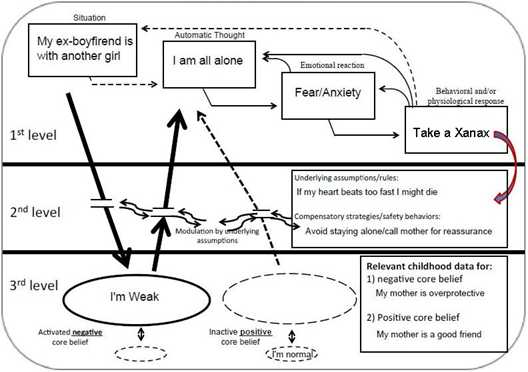
Beck’s Cognitive Model – Part 1 – Application to Therapy
August 25, 2014
Suicide – Is CBT the answer? A practical look at CBT
September 1, 2014Beck’s Cognitive Model – Part 2 – The First Session
The first Session
During the first session of therapy, I find it useful to use a conceptualisation diagram, in order to make the cognitive model easier for the patient to understand. It also allows me to establish an orderly approach to identifying automatic thoughts, intermediate beliefs and core beliefs. The model I prefer was developed for use in Trial-Based Cognitive Therapy (de Oliveira, 2012), but is not limited to this approach, as its components are the same ones found in conventional CBT. Below is a schematic representation I created of a patient, let's call her Maria, who suffered from severe panic attacks:

In the first level of information processing shown above, a situation appraised by the patient as dangerous (Automatic Thought (AT) box) would elicit anxiety (emotional reaction box) that could paralyse her (behavioural and physiological responses box). Arrows returning to the emotional reaction, ATs and situation boxes inform the patient about the circular nature of these interactions (confirmatory bias) that prevent Maria from reappraising the situation and consequently changing the erroneous perceptions it triggered. This diagram might also be useful to make the patient understand that behaviours used in specific situations that elicit less anxiety and consequently yield a sense of immediate relief (e.g., avoidance) may progressively become a safety behaviour (arrow directed from the behavioural and physiological responses box from the first to the second level on the right side of the picture). This means that perceptions in the first level may progressively become Underlying Assumptions (UAs) or rules that are now maintained by the compensatory strategies and safety behaviours (confirmatory bias) seen in the second level. Safety behaviours then assume a modulatory function. Under the influence of the UAs that support such behaviours, first level appraisals (ATs) may be repeatedly confirmed. Also, third level (unconditional) Core Beliefs (CBs) may be activated if UAs are challenged (for example, during exposure), or inactivated if UAs are not challenged (for example, by avoidance).

